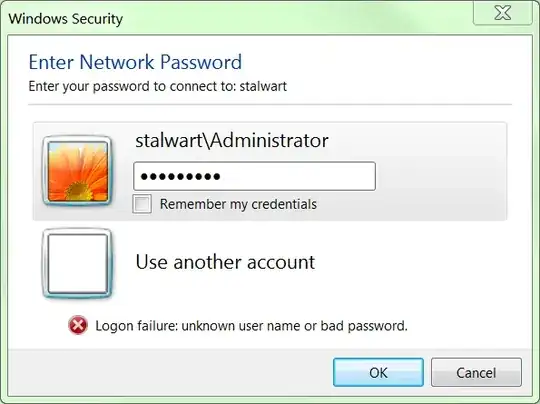i'm trying to access the shares on a server. The credential box appears, and i enter in a correct username and password, and i get access denied.
The silly thing is that i can Remote Desktop to the server (using the same credentials), and i can check the Security event log for the access denied errors:
Event Type: Failure Audit
Event Source: Security
Event Category: Account Logon
Event ID: 681
Date: 3/19/2011
Time: 11:54:39 PM
User: NT AUTHORITY\SYSTEM
Computer: STALWART
Description:
The logon to account: Administrator
by: MICROSOFT_AUTHENTICATION_PACKAGE_V1_0
from workstation: HARPAX
failed. The error code was: 3221225578
and
Event Type: Failure Audit
Event Source: Security
Event Category: Logon/Logoff
Event ID: 529
Date: 3/19/2011
Time: 11:54:39 PM
User: NT AUTHORITY\SYSTEM
Computer: STALWART
Description:
Logon Failure:
Reason: Unknown user name or bad password
User Name: Administrator
Domain: stalwart
Logon Type: 3
Logon Process: NtLmSsp
Authentication Package: NTLM
Workstation Name: HARPAX
Looking up the error code (3221225578), i get an article on Technet:
Audit Account Logon Events By Randy Franklin Smith
...
Table 1 - Error Codes for Event ID 681
Error Code Reason for Logon Failure 3221225578 The username is correct, but the password is wrong.
Which would seem to indicate that the username is correct, but the password is wrong.
i've tried the password many times, uppercase, lowercase, on different user accounts, with and without prefixing the username with servername\username.
What gives that i cannot access the server over file sharing, but i can access it over RDP?

Edit: i tried entering random credentials (i.e. username: ramdom), just to make sure i'm trying to connect to the correct server. The event log on the server shows the failed attempt:
Event Type: Failure Audit Event Source: Security Event Category: Logon/Logoff Event ID: 529 Date: 3/20/2011 Time: 8:40:28 AM User: NT AUTHORITY\SYSTEM Computer: STALWART Description: Logon Failure: Reason: Unknown user name or bad password User Name: random Domain: HARPAX Logon Type: 3 Logon Process: NtLmSsp Authentication Package: NTLM Workstation Name: HARPAX
Edit: Trying all possible LAN Manager Authentication Levels (secpol.msc -> Security Settings -> Local Policies -> Security Options -> LAN Manager Authentication Levels):
- Send LM & NTLM responses: Fails
- Send LM & NTLM - use NTLMv2 session security if negotiated: Fails
- Send NTLM response only (default): Fails
- Send NTLMv2 response only: Fails
- Send NTLMv2 response only\refuse LM: Fails
- Send NTMLv2 response only\refuse LM & NTLM: Fails
(Client: Windows 7. Server: Windows 2000 Server)